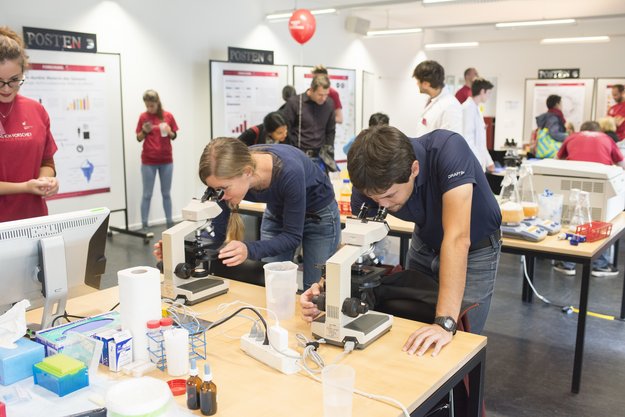Spreading scientific knowledge and passion
Communicating research activities and its relevance to the public is an important goal of the NCCR RNA & Disease. The network is committed to share its findings and passion for science beyond the scientific community.
This summer, the NCCR RNA & Disease conveyed its scientific activities by participating in two of the most visited science exhibitions in Switzerland: At the Scientifica in Zu?rich, the NCCR gave insights into how big data reveals the roles of microRNAs, and at the “Nacht der Forschung” in Bern, the NCCR was represented with an interactive “RNA-Parcours”.
Small worms and big data:


This year’s edition of the Scientifica – Zurich Science Days, was running under the theme big data and attracted over 30’000 visitors. The NCCR RNA & Disease was present with a booth, at which visitors were taken on a journey to learn about miRNAs, the role of big data for their study and the therapeutic potential of small RNAs. Visitors were told how initial discoveries made through basic research with the model organism C. elegans translate decades later into drugs undergoing clinical trials. A number of visitors were surprised to hear that the genome of these tiny worms they were looking at with microscopes contains approximately the same number of protein-coding genes as theirs. Especially the “do it yourself microscope” based on a webcam attracted a lot of attention. Visitors could create themselves “RNA drugs” with the use of a puzzle and were given instructions how to create an alignment of members of a given miRNA family with just a couple of clicks using the miRBase-database. We would like to thank the groups of Constance Ciaudo, Helge Grosshans, Jonathan Hall, Markus Stoffel and Mihaela Zavolan for their contributions. Special thanks go to Marc Duseiller and Urs Gaudenz for their support regarding the DIY microscope and to Justine Kusch from the Scientific Center for Optical and Electron Microscopy of ETH Zurich.
A “Parcours” through the central Dogma – from DNA to RNA to Protein – and beyond:
At the “Nacht der Forschung” at the University of Bern, guests could explore the world of RNA by visiting the interactive NCCR RNA & Disease “Parcours”. Besides a number of posters and videos illustrating our research, the visitors had the unique opportunity to directly learn from scientists and to carry out experiments on-site. Six Bernese NCCR groups with over 50 researchers represent- ed the NCCR RNA & Disease at this event. At this occasion, the NCCR RNA & Disease management would like to thank the groups of Rory Johnson, Oliver Mu?hlemann, Mariusz Nowacki, Norbert Polacek, Marc-David Ruepp, and Andre? Schneider for their invaluable contributions.
While taking a walk through the “Parcours”, visitors observed their own cells under the microscope, isolated DNA from bacteria and discovered the differences between the macromolecules DNA and RNA. By playing “molecular grammar”, they learned in a playful way the importance of RNA splicing, and in the “dark matter of the genome” visitors discovered that RNA molecules are produced almost from the entire genome. At the "RNA as a tool" booth, a real-time experiment visualized the effect of RNA interference under the microscope and our scientists explained the widely mentioned methodology of CRISPR-Cas. Reaching the final station of the Parcours, the guests took over the task of a ribosome and translated the information of a messenger RNA by using the genetic code into the recipe for their favorite cocktail, which was then pipetted by the researchers at the molecular bar. Colorful cocktails revealed correct translation, while a black drink indicated erroneous translation. Luckily, in this case, all drinks were enjoyable - which is not always the case for translation errors in our cells!
By Larissa Grolimund and Dominik Theler



